In-Depth with the Windows 8 Consumer Preview
by Andrew Cunningham, Ryan Smith, Kristian Vättö & Jarred Walton on March 9, 2012 10:30 AM EST- Posted in
- Microsoft
- Operating Systems
- Windows
- Windows 8
As soon as the setup process is finished, you’re presented with your first look at Windows 8’s primary innovation: Metro. This new UI, which originated in Windows Phone 7 and has since been extended to the Xbox 360, is the Wave of the Future at Microsoft, and it’s part and parcel of Windows 8. There is no classic Start menu to fall back on. There’s nothing built-in to the OS that allows you to disable it or boot to the desktop by default (though surely various hacks will enable this if they haven’t already). Metro is here, and if you use Windows 8 you’ll have to come to terms with it.
That’s because Microsoft is going a step further than Apple with regards to its operating systems: while Apple is busy porting iOS features and characteristics to a desktop operating system that is still recognizably OS X, Microsoft insists that the tablet is just another kind of PC, and to that end is building a unified OS for both tablets and traditional PCs. Microsoft tablets (whether running Windows 8 or Windows on ARM) will run the same core software as PCs, will be able to run many of the same apps as PCs, and (most importantly for Microsoft’s ecosystem of enterprise users) can be managed using the same tools as PCs. We’ve known for years that the traditional Windows desktop doesn’t work well on tablets, but does an interface designed for touch also work with a mouse and keyboard?
 Metro, with its large fonts, bold colors, and large buttons was designed to be touched, and I think once we get some tablets designed for Windows 8 people are going to warm up to it. It’s well thought-out and with a little polishing will stand up well to iOS and Android in terms of features, and in terms of aesthetics it's already there—animations are fluid and attractive, and nice touches like a volume overlay (see right—finally!) bring an extra level of modern polish to Windows.
Metro, with its large fonts, bold colors, and large buttons was designed to be touched, and I think once we get some tablets designed for Windows 8 people are going to warm up to it. It’s well thought-out and with a little polishing will stand up well to iOS and Android in terms of features, and in terms of aesthetics it's already there—animations are fluid and attractive, and nice touches like a volume overlay (see right—finally!) bring an extra level of modern polish to Windows.
Brian Klug and Ryan Smith talked a bit about using Metro on a tablet in their piece on September’s Windows 8 Developer Preview, a process which is more or less the same in the Consumer Preview, so what I’ll be focusing on here is the general layout and function of Metro in the Consumer Preview, and my experience using it with a keyboard and mouse.
Introducing Metro
We’ll start with the entry point: the new login/lock screen. In previous Windows versions, this screen told you nothing about the computer—it was simply a gateway, and as such it either showed you a list of user accounts on the computer or displayed a CTRL + ALT + DELETE prompt with username and password fields. In Windows 8, the lock screen shows you the date and time and your current battery life and network connectivity status, set against a user-configurable background. Other Metro apps, like Mail and Messages, can also be configured to display status and notification messages on the lock screen. The look is reminiscent of most tablets and smartphones, but its big, high-resolution, striking images reminded me more of the Kindle Fire than anything. It’s a nice effect.
Press any key on your keyboard and the login image will slide upward, revealing the traditional Windows name and password fields. Authenticate, and you’ll be looking at the Metro-style Start screen.
Tiles for Metro-style apps are big and colorful, and can usually be set to two sizes, a smaller square that allows for two tiles to sit side by side in a column, and a longer rectangle that spans the entire column. Metro columns on the Start screen will expand or contract to fill all of the screen resolution available to them, as evidenced in the screenshots above and below, and your mouse or trackpad’s vertical scrolling function will let you move left and right (horizontally, I know) through all of your apps. You can also scroll by grabbing the scrollbar at the bottom of the screen, or by moving your mouse pointer all the way to the left or the right of the screen.
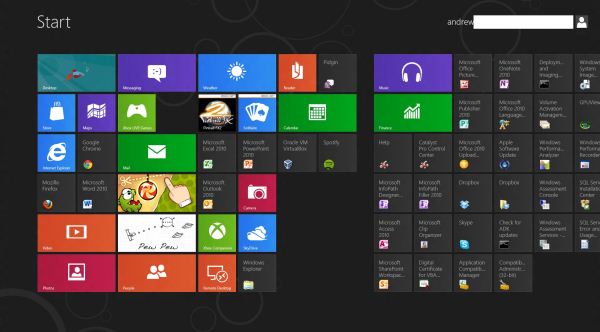
Displays with more pixels can display more items
Above, you can see most of what constitutes a Metro page: tiles of apps lined up into neat columns. Tiles can be moved around at will, and will try their best to rearrange themselves dynamically. The wider gap between two of the columns is a divider between “pages” of apps. There is no limit to the horizontal size of pages, and you can freely drag tiles to either side of these wider divides.
Right-clicking a Metro app will bring up a list of actions at the bottom of the screen—most Metro tiles will let you shorten or lengthen them, remove them from the Start screen, or uninstall them.
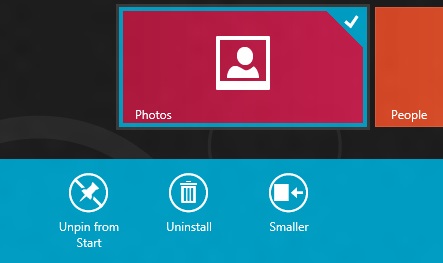
Standard desktop programs also show up on the Start screen as rather unglamorous-looking gray tiles that show the name of the program and its icon. Left clicking on it will dump you to the desktop and open the app as it would open in older versions of Windows, and right-clicking will bring up that app’s standard right-click menu in the Metro style across the bottom of the screen, with the added option to uninstall the program without going into the Programs and Features control panel.
To add and remove desktop app icons from the Start screen, right-click them and then click “pin to Start.” Desktop apps can be pinned to and unpinned from the desktop taskbar and the Start screen from the desktop or from Metro, the first of many ways in which the two interfaces are integrated.
Windows Search can be invoked automatically from the Start screen if you begin typing. In Windows 8, there are three distinct search categories: Apps, which will display most Metro and desktop programs; Settings, which will search through the Metro and desktop control panels; and Files, which is self-explanatory. You can also search through any Windows Search-enabled Metro app, which you can see listed below the three main headings. I’d love to see a unified search group like we had in the Windows 7 Start menu, especially given the sometimes-blurry line between what appears in Settings and what appears in Apps, but search in Windows 8 is powerful and it’s fast, even using slower processors and mechanical HDDs.
All Metro apps, including the desktop, can be “snapped” to the left or right edge of the screen, which lets one app use up about a fifth of the screen while another app uses the remaining space—I’ve seen this called “Metro Snap” and that’s how I’ll refer to it for the rest of the article. This is especially useful for things like Twitter or messaging clients that work well with a single vertical strip of screen space. Metro Snap will only work on panels that are 1366x768 or higher—anything smaller has too few horizontal pixels to make effective use of the feature—but the Windows desktop’s Aero Snap features will continue to work as they did in Windows 7.
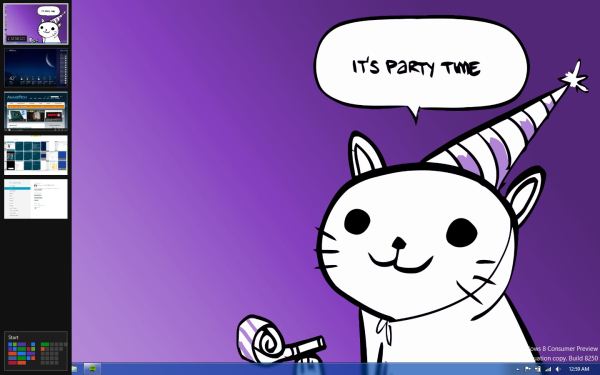
Party Cat knows when it is time to party. Also, the app drawer is on the left.
Metro has a few menus that can always be brought up no matter what app you’re using: the left edge of the screen is for an application drawer (above), which serves a function similar to the application switchers in iOS and Android. It shows all of your currently running apps and allows you to either switch to them from the currently running app or close them. The desktop will show up in the application drawer as a single item regardless of how many programs you have running on it, and while you can “close” it, this only makes the tile vanish from the drawer, and won’t close any of the programs running on the desktop.
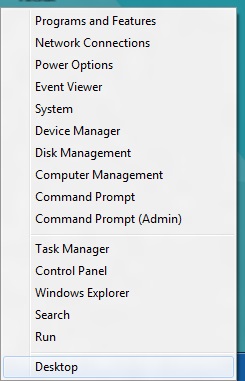
Update: Several readers have pointed out that right-clicking in the lower left corner of the screen brings up a mini-Start menu of sorts, where the Explorer, Search, the Run dialog box and several control panels can be accessed more easily. Thanks to all who sent this in!
The right edge of the screen is for Charms (above), Microsoft’s name for the buttons that let you access several high-level settings and features. The Charms are, from top to bottom:
- Search, which brings up the Search menu (which, remember, can also be invoked by typing from the Start screen). The default search view is Apps.
- Share. While in a Metro app like Photos, you could use this charm to send a picture to someone using another Metro app like Mail.
- Start, which brings up the Start screen.
- Devices, which brings up attached devices like printers and extra monitors and gives you some configuration options for them—for instance, it will allow you to change your display settings if you’ve got a second monitor or projector attached, and it will bring up a Print menu if you click an attached printer. This charm is context-sensitive—if there’s nothing in your app to print (or if the app doesn’t support it), for example, any printers attached to your computer won’t show up in the menu as a selectable option.
- Settings. This brings up both general settings and options for the currently-running application as well as some system-wide settings like brightness, volume, notifications, language, network connectivity, and shutdown options. The “More PC Settings” link brings up the system-wide Metro control panel, where one can control things like the lock screen and Metro backgrounds, your PC’s refresh and reset functionality, and a few other settings.
Screen resolution requirements
As we’ve discussed, using Metro Snap requires a screen resolution of at least 1366x768, but there’s one more very important resolution requirement in Windows 8.
While working on my netbook, I quickly found that almost all Metro apps included in the Consumer Preview wouldn’t run on its 1024x600 display. After some research I found that, yes, Metro apps are only going to run on screens that are 1024x768 or higher. It’s important to give developers a minimum screen resolution to shoot for (and we may even see some tablets that use 1024x768 panels, given the precedent set by the iPad, the HP TouchPad, and others), but it means that users of PCs with smaller screens aren’t going to be able to use Windows 8’s defining feature (though the Start screen and system menus will still work just fine). This is too bad, since the limited amount of screen space on a netbook is a decent fit for Metro's simplified interface and full-screen apps.
Now that you know the basic features and layout of Metro, it’s time to teach you how to use it with a mouse and keyboard.


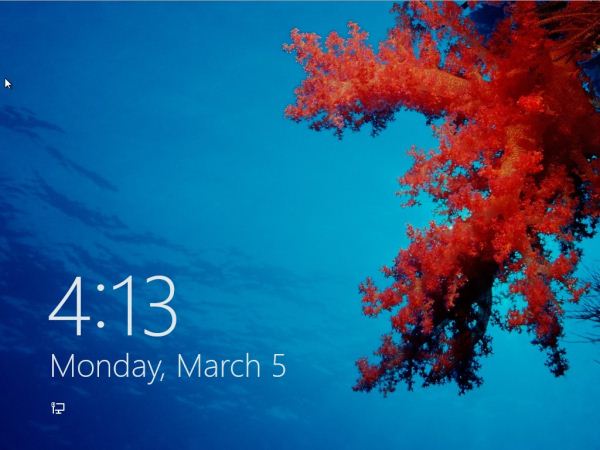
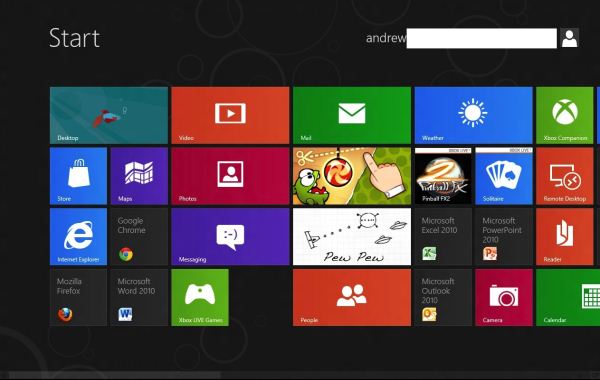
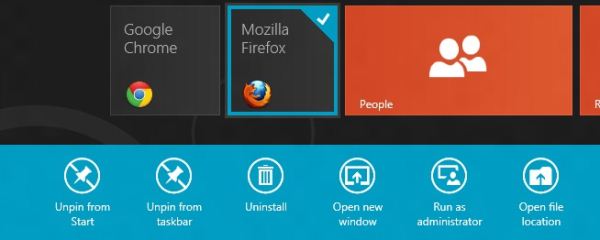
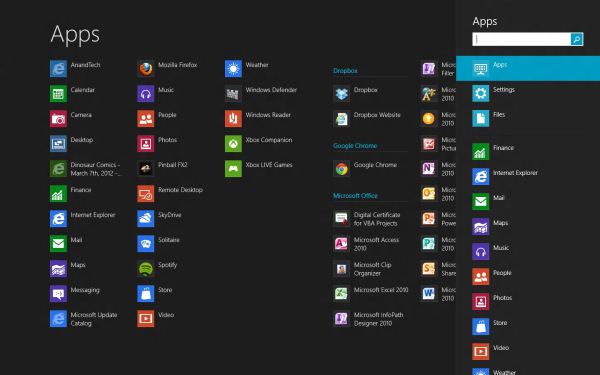
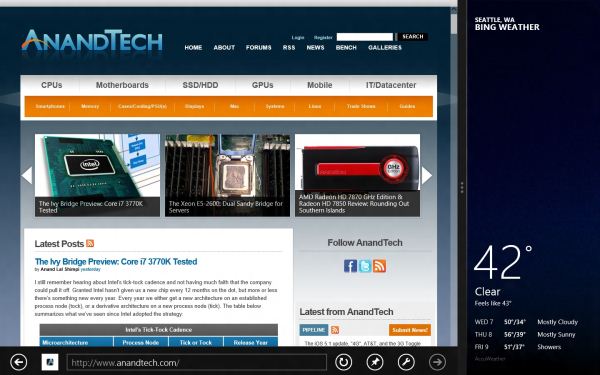
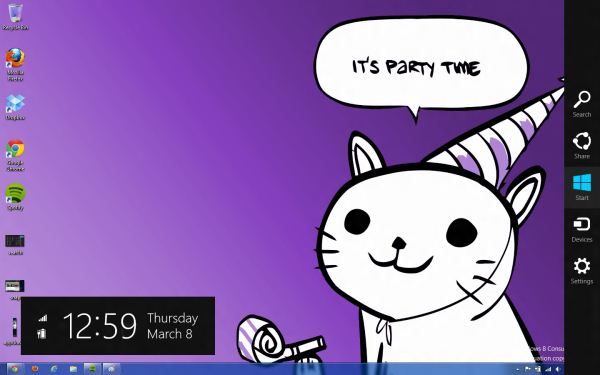








286 Comments
View All Comments
yannigr - Thursday, March 15, 2012 - link
May I say something here?Sorry for my English in advance.
I don't know if your work at Anandtech is a full time job or more like an occasional work. When you see a site like Anandtech you think that this is more like a big company with full time employees not a site with people that come and go just to write an article, or a review, at their spare time with hardware that they buy or if they are lucky get from the big companies as a gift for a presentation/review.
So when you are thinking Anandtech (and this is where maybe we misjudge you) as a big company you don't expect to read stuff that you read from a 16 years old kid in a small forum with 2-5-10 thousand members about his last review. I can not accept an excuse like this that you give. If you are in the BIGGEST and MORE RESPECTED hardware review site on the internet, and I don't think I am wrong here, you buy hardware that you also DO NOT LIKE or is not good enough for YOU. Why? Because that is your job or/and because you are writing for ANANDTECH not YannigrTech.
When you have the time to fast-test 8 machines you try to find an AMD system and even if it exists a system with VIA hardware. I know I must be joking with the last one about VIA. Well, I am not. I do think that if there was a VIA system in there many would be posting about how they were surprised about that. Even if they where laughing at it's performance it would have been a plus for the review.
Think a review many pages long about the next 3DMark only with AMD gpus because the reviewer don't find Nvidia gpus good enough. Many Nvidia fans would have been disappointed, to put it mildly.
Anyway the first post was written just for fun, because I know that Intel don't only have the better hardware but also the biggest influence not only at hardware sites but in people's minds too. Between two equal systems most just choose Intel because it is an Intel.
This post was whiten only because I was not expecting someone that writes for Anandtech to say that:
I only have Intel, I am not buying AMD because it is just not good enough for me.
Last. Thanks for the review. No joking here. It was interested and useful.
Andrew.a.cunningham - Monday, March 19, 2012 - link
First, thanks for reading! I'm glad you found the review useful. Second, I want to try to answer some of your questions as to how AnandTech (and most new outlets on the Internet) work.Most writers who get paid are not working full-time positions. This is true both of independently owned websites like AnandTech, corporate-owned sites like IGN, or even big-time traditional publications like the New York Times. Most sites will contract freelancers rather than full-time workers both because of cost (freelancers are almost universally paid less than salaried employees and get no benefits) and administrative reasons (full-time employees mean that you've got to start paying attention to things like benefits and payroll taxes, necessitating a larger administrative staff to handle things like accounting).
Different outlets handle things in different ways - at AnandTech, the pay is OK for contractors, and most of us can bother Anand himself if we have questions about a story we're working on. On other sites (to cherry-pick an extreme example, let's call out the Huffington Post), freelancers are sometimes paid nothing, and are rather compensated with "exposure" and clips that they could in theory use to land a paying gig later on. I think what HuffPo (and, really, any profitable publication that doesn't pay its writers) does is a scam and I've got some strong feelings about it, but that's not my main point - my point is that much of what you read on the Internet is being written by people who don't write on the Internet full time. At AnandTech, even the senior editors are contracted freelancers rather than full-time employees.
Different people write for different reasons, but my goal is to make a living at it - I'm doing it because I love it, sure, but I'm also doing it because there are bills to pay. To do that, I cannot and will not spend $500 on hardware to use in a review that will earn me quite a bit less than $500. As anyone can tell you, that math doesn't add up, and since this is a review of the beta version of an x86-compatible Windows product - a product that looks and acts the same on any hardware that meets the minimum requirements - it's frankly not as important as a few of you seem to think it is. And that's all I have to say about it.
yannigr - Monday, March 19, 2012 - link
I still believe that you should buy an AMD system. Not today or tomorrow but the next time you would need an extra machine. But that's me.Thanks for answering my post :-)
Andrew.a.cunningham - Monday, March 19, 2012 - link
I'll look into it for sure. Trinity has my interest piqued. :-)TC2 - Sunday, March 11, 2012 - link
AMD?This isn't the point! Andrew Cunningham here hasn't downside. I want to ask, what is the problem here? The recent Intel CPUs a far superior than the amd cpus! And, if you want to know the best sides of W8 ... the amd just isn't the first choice ... :)))
silverblue - Monday, March 12, 2012 - link
At the time Andrew got those machines, the best option across the board likely would've been Intel. The Atom build is thoroughly outclassed by Brazos but it simply wasn't available at the time.It's only really the past twelve months to fifteen months where AMD has actually had a viable range of mobile processors for netbooks and larger.
medi01 - Monday, March 12, 2012 - link
Name something "far superior" to AMD A8 3850 that has comparable cost.TC2 - Wednesday, March 14, 2012 - link
Oops to daisies :) It would make a god to tears!You and all amd-fans, are very funny!
When the conversation is about cores - "amd has twice than Intel" ?!
When the conversation is about performance - "the cost isn't comparable" ?!
When the conversation is about CPU - "amds APU is bla-bla..." ?!
When the conversation is about benchmarks - "look look, the BD is almost like Nehalem (btw. 2 generations older)" ?!
All those is UNTRUE!!! And remember well - I and many-many people doesn't give a shit about amds green presentations, cores and so ... We need fast CPU in ST as well as MT, and fast GPU! And believe me, esp. in professional segment amd got nothing significant :)))
chucky2 - Friday, March 9, 2012 - link
I'd like for you to do an article on feature support of DirectX 9 cards under say Windows XP SP3 vs Windows 8. I know AMD dropped support for their DirectX 9 based cards before their 10.2 (Feb 2010 driver set), and then later belatedly added 10.2 as the last supported driver. My interest is in if they've dropped proper support of their cards in Vista/7/and now 8 rather than putting in the (very likely minimal) work to properly support them.Thanks for the article!
Andrew.a.cunningham - Friday, March 9, 2012 - link
The 10.2 driver was only supported under Vista, but in my experience it works fine for Windows 7, which means it should work OK in Windows 8. One of the iMacs I tested on used a Radeon X1600 Mobility card - I installed the Vista-certified driver off of a Snow Leopard DVD and didn't see any crashes or instability, but your mileage may vary.